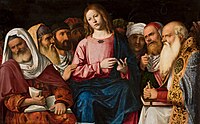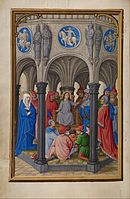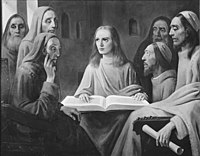
In Christianity, the Visitation, also known as the Visitation of the Blessed Virgin Mary, refers to the visit of Mary, who was pregnant with Jesus, to Elizabeth, who was pregnant with John the Baptist, in the Gospel of Luke, Luke 1:39–56. The episode is one of the standard scenes shown in cycles of the Life of the Virgin in art, and sometimes in larger cycles of the Life of Christ in art.
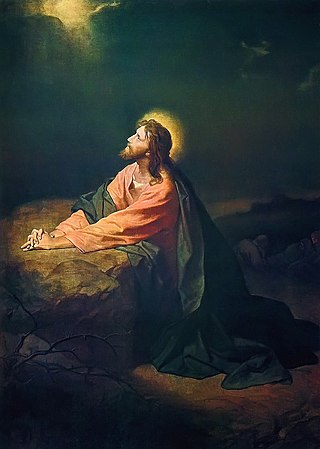
The Agony in the Garden of Gethsemane is an episode in the life of Jesus, which occurred after the Last Supper and before his betrayal and arrest, all part of the Passion of Jesus leading to his crucifixion and death. This episode is described in the three Synoptic Gospels in the New Testament. According to these accounts, Jesus, accompanied by Peter, John and James, enters the garden of Gethsemane on the Mount of Olives where he experiences great anguish and prays to be delivered from his impending suffering, while also accepting God's will.

The flight into Egypt is a story recounted in the Gospel of Matthew and in New Testament apocrypha. Soon after the visit by the Magi, an angel appeared to Joseph in a dream telling him to flee to Egypt with Mary and the infant Jesus since King Herod would seek the child to kill him. The episode is frequently shown in art, as the final episode of the Nativity of Jesus in art, and was a common component in cycles of the Life of the Virgin as well as the Life of Christ. Within the narrative tradition, iconic representation of the "Rest on the Flight into Egypt" developed after the 14th century.

The baptism of Jesus, the ritual purification of Jesus with water by John the Baptist, was a major event described in the three synoptic Gospels of the New Testament. It is considered to have taken place at Al-Maghtas, today located in Jordan.

The Parable of the Lost Sheep is one of the parables of Jesus. It appears in the Gospels of Matthew and Luke. It is about a man who leaves his flock of ninety-nine sheep in order to find the one which is lost. In Luke 15, it is the first member of a trilogy about redemption that Jesus addresses to the Pharisees and religious leaders after they accuse him of welcoming and eating with "sinners."
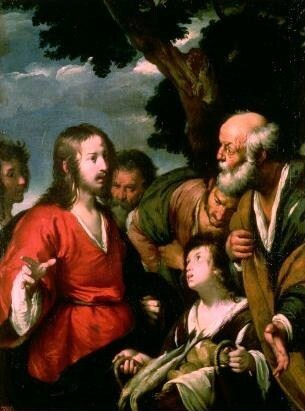
In Christianity, feeding the multitude comprises two separate miracles of Jesus, reported in the Gospels, in which Jesus used modest resources to feed thousands of followers who had gathered to see him heal the sick.
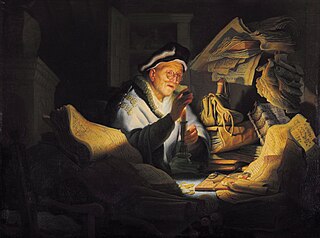
The Parable of the Rich Fool is a parable of Jesus which appears in the Gospel of Luke. It depicts the futility of the belief that wealth can secure prosperity or a good life.

The parable of the Pharisee and the Publican is a parable of Jesus that appears in the Gospel of Luke. In Luke 18:9–14, a self-righteous Pharisee, obsessed by his own virtue, is contrasted with a tax collector who humbly asks God for mercy.
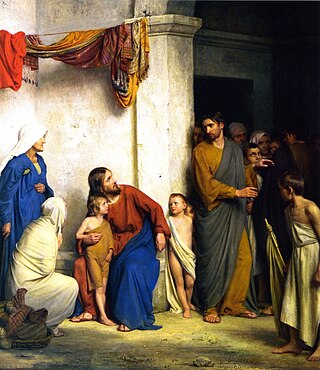
Jesus' teachings referring to little children and infants/babies appear in a few places in the New Testament and in the non-canonical Gospel of Thomas.

The miraculous catch of fish, or more traditionally the miraculous draught of fish(es), is either of two events commonly (but not universally) considered to be miracles in the canonical gospels. The miracles are reported as taking place years apart from each other, but in both miracles apostles are fishing unsuccessfully in the Sea of Galilee when Jesus tells them to try one more cast of the net, at which they are rewarded with a great catch (or "draught", as in "haul" or "weight"). Either is thus sometimes called a "miraculous draught of fish".
Matthew 15:28 is a verse in the fifteenth chapter of the Gospel of Matthew in the New Testament.

The kiss of Judas, also known as the Betrayal of Christ, is the act with which Judas identified Jesus to the multitude with swords and clubs who had come from the chief priests and elders of the people to arrest him, according to the Synoptic Gospels. The kiss is given by Judas in the Garden of Gethsemane after the Last Supper and leads directly to the arrest of Jesus by the police force of the Sanhedrin.

The Finding of the Saviour in the Temple (1854–1860) is a painting by the English artist William Holman Hunt intended as an ethnographically accurate version of the subject traditionally known as "Christ Among the Doctors", an illustration of the child Jesus debating the interpretation of the scripture with learned rabbis. The passage illustrated is from the Gospel of Luke, 2:41, which states:
Every year his parents went to Jerusalem for the Feast of the Passover. When he was twelve years old, they went up to the Feast, according to the custom. After the Feast was over, while his parents were returning home, the boy Jesus stayed behind in Jerusalem, but they were unaware of it. Thinking he was in their company, they traveled on for a day. Then they began looking for him among their relatives and friends. When they did not find him, they went back to Jerusalem to look for him. After three days they found him in the temple courts, sitting among the teachers, listening to them and asking them questions. Everyone who heard him was amazed at his understanding and his answers. When his parents saw him, they were astonished. His mother said to him, "Son, why have you treated us like this? Your father and I have been anxiously searching for you." "Why were you searching for me?" he asked. "Didn't you know I had to be in my Father's house?" But they did not understand what he was saying to them.
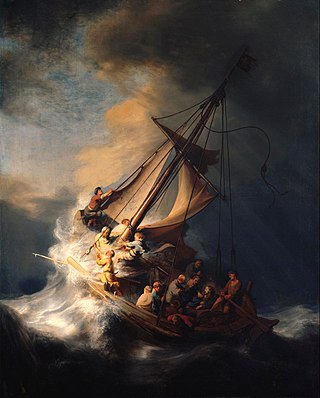
Calming the storm is one of the miracles of Jesus in the Gospels, reported in Matthew 8:23–27, Mark 4:35–41, and Luke 8:22–25. This episode is distinct from Jesus' walk on water, which also involves a boat on the lake and appears later in the narrative.

Healing the paralytic at Capernaum is one of the miracles of Jesus in the synoptic Gospels. Jesus was living in Capernaum and teaching the people there, and on one occasion the people gathered in such large numbers that there was no room left inside the house where he was teaching, not even outside the door. Some men came carrying a paralyzed man but could not get inside, so they made an opening in the roof above Jesus and then lowered the man down. When Jesus saw how faithful they had been, he said to the paralyzed man, "Son, your sins are forgiven."

Jesus at the home of Martha and Mary, in art usually called Christ in the House of Martha and Mary, and other variant names, is a Biblical episode in the life of Jesus in the New Testament which appears only in Luke's Gospel, immediately after the Parable of the Good Samaritan. Luke's account reads:

The Bread of Life Discourse is a portion of the teaching of Jesus which appears in chapter 6 of John's Gospel and was delivered in the synagogue at Capernaum.
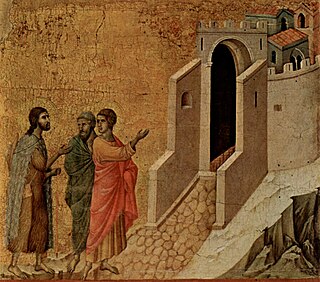
According to the Gospel of Luke, the road to Emmaus appearance is one of the early post-resurrection appearances of Jesus after his crucifixion and the discovery of the empty tomb. Both the meeting on the road to Emmaus and the subsequent supper at Emmaus, depicting the meal that Jesus had with two disciples after the encounter on the road, have been popular subjects in art.

This narrative is told in Matthew 13:1-3, Mark 4:1, and Luke 5:1-3. Owing to the vast crowds that followed him from the surrounding towns and villages to listen to his doctrine, Jesus retired to the sea coast. There he entered a boat, that he used as a pulpit, and addressed the crowd on the shore.

In the Gospel of Luke only, Jesus follows the beatitudes with a set of woes, denouncing the opposite to the blessings as the source of condemnation and punishment. These woes are universal and differ from the woes of the Pharisees.







